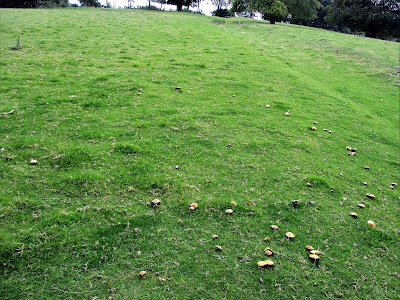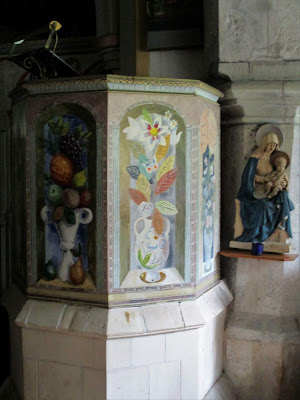 Putting a rubbish ten days behind us, Son the Younger, Ted and I headed north into the Cotswolds for a walk. Our starting point was the village of Miserden, but before we set off, we took a look at the war memorial, designed by Lutyens.
Putting a rubbish ten days behind us, Son the Younger, Ted and I headed north into the Cotswolds for a walk. Our starting point was the village of Miserden, but before we set off, we took a look at the war memorial, designed by Lutyens. Their experiences, 100+ years ago, infinitely worse.
We also popped into St Andrew's Church, which is believed to be of Saxon origin, but suffered drastic 'restoration' during the Victorian era.
It has a probably Norman but possibly earlier font ...
 ... but its glories are the two tombs in the manorial chapel. This is William Kingston's painted stone effigy; he died in 1614 and seems to have been a snazzy dresser.
... but its glories are the two tombs in the manorial chapel. This is William Kingston's painted stone effigy; he died in 1614 and seems to have been a snazzy dresser.  And this is the alabaster tomb of Sir William Sandys and his wife, Margaret Culpeper, who died in 1640 and 1644 respectively.
And this is the alabaster tomb of Sir William Sandys and his wife, Margaret Culpeper, who died in 1640 and 1644 respectively. Memorial to Anthony Partridge (dd 1591) and his wife
The route of our walk took us along a lane ...
... over a couple of stone stiles ...
... past Miserden (or Misarden) Park, which dates from the 1620s and was remodelled by Lutyens in 1919 after a major fire ...
... past a fairy ring ...
... and down the steep path through the woods to the bottom of the valley and the River Frome (Stroudwater). Not to be confused with the Fromes in Bristol, Somerset, Dorset and Herefordshire respectively.
As at Berwick in Sussex last week, it was beginning to look a little autumnal.
Of course, what slithers down must clamber up the other side of the valley, which is pretty steep also.
At the top we found ourselves in typical Cotswold country - all very gracious and strictly private, gitorfmyland even when you're on a public footpath.
We made our way - briskly and purposefully because we belonged there - to the nearby village of Winstone and detoured down a lane to its church, St Bartholomew's ...
... which, like Holcombe Old Church in Somerset, is believed to have been left behind when the village moved to higher ground as a precaution against the plague.
This church is mid 11th century and has a mixture of Saxon and Norman features, with a 14th century porch and a 15th century saddleback tower.
A very Saxon-looking South door ...
... and chancel arch.
Like at Miserden, the church here underwent 'restoration' at the hands of the Victorians, losing its plaster, and with it layers of history. Instead, it got some rather nasty ribbon-pointing.
Look, Ma, no East Window
Crowned head over blocked north doorway
Modern window, featuring The Sower, by local stained glass artist, Edward Payne, whose father, Henry, had close links with the Arts and Crafts Movement.
15th century font
Feet of ages
Life and death
Just death
Time to be looping back to Miserden.
Various obstacles for Ted: another stone stile ...
... and some hens and ferocious-looking geese, all of which he paid no attention to at all. Hooray. It's only taken 10 years.
The final part of the walk was the scramble down to the river and the hauling back up the other side. Son the Younger likes to end a walk with a stiff climb, it gives him a sense of achievement, he says. But then he's 32 years younger than I am.































































